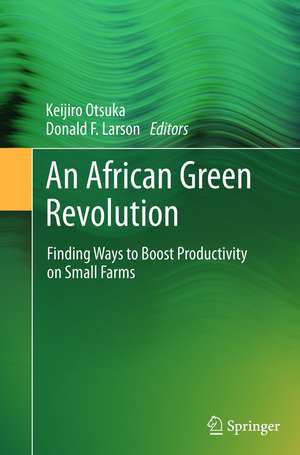An African Green Revolution: Finding Ways to Boost Productivity on Small Farms
Editat de Keijiro Otsuka, Donald F. Larsonen Limba Engleză Paperback – 29 ian 2015
| Toate formatele și edițiile | Preț | Express |
|---|---|---|
| Paperback (1) | 641.53 lei 6-8 săpt. | |
| SPRINGER NETHERLANDS – 29 ian 2015 | 641.53 lei 6-8 săpt. | |
| Hardback (1) | 651.51 lei 6-8 săpt. | |
| SPRINGER NETHERLANDS – 22 dec 2012 | 651.51 lei 6-8 săpt. |
Preț: 641.53 lei
Preț vechi: 754.74 lei
-15% Nou
Puncte Express: 962
Preț estimativ în valută:
122.77€ • 127.70$ • 101.36£
122.77€ • 127.70$ • 101.36£
Carte tipărită la comandă
Livrare economică 15-29 aprilie
Preluare comenzi: 021 569.72.76
Specificații
ISBN-13: 9789401783682
ISBN-10: 9401783683
Pagini: 320
Ilustrații: XVIII, 302 p.
Dimensiuni: 155 x 235 x 17 mm
Greutate: 0.45 kg
Ediția:2013
Editura: SPRINGER NETHERLANDS
Colecția Springer
Locul publicării:Dordrecht, Netherlands
ISBN-10: 9401783683
Pagini: 320
Ilustrații: XVIII, 302 p.
Dimensiuni: 155 x 235 x 17 mm
Greutate: 0.45 kg
Ediția:2013
Editura: SPRINGER NETHERLANDS
Colecția Springer
Locul publicării:Dordrecht, Netherlands
Public țintă
GraduateCuprins
Contents:.- 1. An Overview .- Part I: Climate and the Transferability of Asian Green Revolution to Sub-Saharan Africa.- 2. Lessons from the Asian Green Revolution in Rice.- 3. The Possibility of a Rice Green Revolution in Large-Scale Irrigation Schemes in Sub-Saharan Africa.- 4. The Declining Impacts of Climate on Crop Yields during the Green Revolution in India, 1972-2002.- 5. The Impact of Technological Changes on Crop Yields in Sub-Saharan Africa, 1967 to 2004.- Part II: Prospects for Upland Rice and Maize Green Revolution in Sub-Saharan Africa.- 6. Causes and Consequences of NERICA Adoption in Uganda.- 7. Impact of NERICA Adoption on Rice Yield: Evidence from West Africa.- 8. Maize Revolutions in Sub-Saharan Africa.- 9. Maize, Soil Fertility, Fertilizer, and the Green Revolution in East Africa.- Part III: The Role of Fertilizer Markets and Fertilizer Application.- 10. Chemical Fertilizer, Organic Fertilizer, and Cereal Yields in India.- 11. The Demand for Fertilizer when Markets are Incomplete: Evidence from Ethiopia.- 12. Technology Adoption in Agriculture: Evidence from Experimental Intervention in Maize Production in Uganda.- Part IV: Conclusion.- 13. Towards a Green Revolution in Sub-Saharan Africa.
Textul de pe ultima copertă
This volume explores the usefulness of the Asian model of agricultural development for Africa, where, even before the recent world food crisis, half the population lived on less than on dollar a day, and a staggering one in three people and one third of all children were undernourished. Africa has abundant natural resources; agriculture provides most of its jobs, a third of national income and a larger portion of total export earnings. However the levels of land and labor productivity rank among the worst in the world. The book explains Africa’s productivity gap and proposes ways to close it, by examining recent experience in Africa and by drawing on lessons from Asia.
Part I surveys the transferability of Asia’s Green Revolution to Sub-Saharan Africa and explores whether Africa should focus on staple crops and small farms. Coverage spans technology, irrigation, climate and agricultural policies in the Asian Green Revolution, and probes whether geography explains why such a revolution has eluded Africa.
Part II discusses two crops which have been considered highly promising, and addresses the issue of low-input vs. high-input agriculture. The authors explore NERICA, a variety of upland rice developed for Africa, and the challenges of establishing a chain of production that improves agriculture and reduces hunger. The section also details the adoption of high-yielding maize varieties throughout Africa, citing case studies on the possibilities of maize Green Revolutions in Kenya and Uganda.
Addressing the poor quality of Africa’s soils and the limited reach of fertilizer markets, Part III shows how markets shape farmer incentives and fertilizer demand and discusses the role of governments in achieving substantial productivity growth.
A recurring theme of the book is thatwhile a handful of innovations in rice and wheat helped bring about large and sweeping changes for farmers and the urban poor in Asia, a broader set of innovations are needed to launch Africa’s Green Revolution. It is the editors’ belief that the conditions for success in Africa are growing rather than diminishing and that the seeds for Africa’s Green Revolution have been sown.
Part I surveys the transferability of Asia’s Green Revolution to Sub-Saharan Africa and explores whether Africa should focus on staple crops and small farms. Coverage spans technology, irrigation, climate and agricultural policies in the Asian Green Revolution, and probes whether geography explains why such a revolution has eluded Africa.
Part II discusses two crops which have been considered highly promising, and addresses the issue of low-input vs. high-input agriculture. The authors explore NERICA, a variety of upland rice developed for Africa, and the challenges of establishing a chain of production that improves agriculture and reduces hunger. The section also details the adoption of high-yielding maize varieties throughout Africa, citing case studies on the possibilities of maize Green Revolutions in Kenya and Uganda.
Addressing the poor quality of Africa’s soils and the limited reach of fertilizer markets, Part III shows how markets shape farmer incentives and fertilizer demand and discusses the role of governments in achieving substantial productivity growth.
A recurring theme of the book is thatwhile a handful of innovations in rice and wheat helped bring about large and sweeping changes for farmers and the urban poor in Asia, a broader set of innovations are needed to launch Africa’s Green Revolution. It is the editors’ belief that the conditions for success in Africa are growing rather than diminishing and that the seeds for Africa’s Green Revolution have been sown.
Caracteristici
Uses primary data to assess the potential for productivity growth in sub-Saharan Africa Describes the Asian experience and assesses the transferability of Asian technology Outlines explicit policy recommendations to realize a Green Revolution in sub-Saharan Africa Includes supplementary material: sn.pub/extras





















